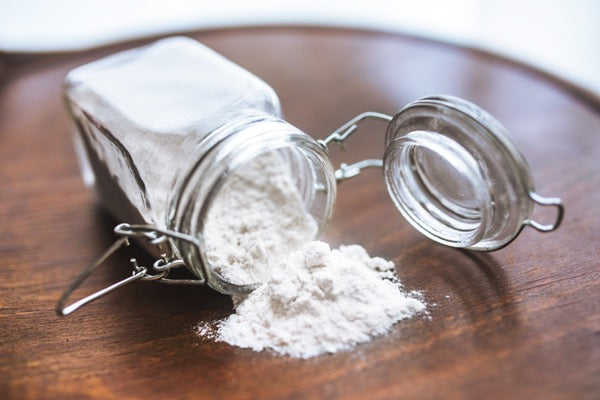January 23, 2024
Blog
What are the Differences in Flour?

Guest Post by Janine McHale, owner of the blog, The Empowered Plate.
What is the best one to use, what are the differences, and how do you know which one to choose? As a holistic health counselor and a baker, I get asked a lot about different types of flour.  The main difference in the types of flour is the protein content. When the protein from wheat is mixed with water it makes gluten. Gluten is what makes the dough have its elastic and doughy texture.
Bread flour – this is made from hard wheat and has a high gluten content which makes this dough more elastic and has a good rise. It’s used for breads, bagels, and pizza crust.
All purpose flour – is made from a mix of hard and soft wheat and is used for cookies and quick breads. It has a medium amount of gluten.
Pastry flour – Also a mix of hard and soft wheat flours with more soft than hard. It makes a lighter texture of pastry than all purpose flour.
Cake flour – this flour has the least amount of gluten and is made from soft wheat. It produces delicate baked goods and can have a tendency to crumble. It can have chlorine added in to allow the flour to hold more liquid and sugar to make a moist cake.
All of the above flours are considered white flours, the bran and germ have been stripped from them. The lack of fiber in them makes them higher on the Glycemic Index, meaning the sugars in them enter the blood stream much faster than whole wheat flours. They can be bleached or unbleached and they can be enriched or not.
Bleached flour – a bleaching agent is literally added in to bleach the flour to a bright white color. It tends to have a finer texture and can have a slightly off metallic taste.
Unbleached flour – plain flour without the bleaching agent added in. It can appear yellowish in color and may have a tendency to clump.
Enriched flour – is flour with specific nutrients added back in. These nutrients include iron and B vitamins; calcium is sometimes also added back in. This process is supposed to add back what has been lost during the stripping of the wheat germ. The fiber is not added back in, however, and enriched flour does not have the same nutritional benefits of whole wheat flour.
Wheat flour - I tend to use whole wheat flour since it has the most nutrition. Whole wheat flour has not had the germ and bran stripped from it so it has a higher fiber content, takes longer to digest and the sugars take longer to enter the bloodstream. It is lower on the Glycemic Index than white flours.
The main difference in the types of flour is the protein content. When the protein from wheat is mixed with water it makes gluten. Gluten is what makes the dough have its elastic and doughy texture.
Bread flour – this is made from hard wheat and has a high gluten content which makes this dough more elastic and has a good rise. It’s used for breads, bagels, and pizza crust.
All purpose flour – is made from a mix of hard and soft wheat and is used for cookies and quick breads. It has a medium amount of gluten.
Pastry flour – Also a mix of hard and soft wheat flours with more soft than hard. It makes a lighter texture of pastry than all purpose flour.
Cake flour – this flour has the least amount of gluten and is made from soft wheat. It produces delicate baked goods and can have a tendency to crumble. It can have chlorine added in to allow the flour to hold more liquid and sugar to make a moist cake.
All of the above flours are considered white flours, the bran and germ have been stripped from them. The lack of fiber in them makes them higher on the Glycemic Index, meaning the sugars in them enter the blood stream much faster than whole wheat flours. They can be bleached or unbleached and they can be enriched or not.
Bleached flour – a bleaching agent is literally added in to bleach the flour to a bright white color. It tends to have a finer texture and can have a slightly off metallic taste.
Unbleached flour – plain flour without the bleaching agent added in. It can appear yellowish in color and may have a tendency to clump.
Enriched flour – is flour with specific nutrients added back in. These nutrients include iron and B vitamins; calcium is sometimes also added back in. This process is supposed to add back what has been lost during the stripping of the wheat germ. The fiber is not added back in, however, and enriched flour does not have the same nutritional benefits of whole wheat flour.
Wheat flour - I tend to use whole wheat flour since it has the most nutrition. Whole wheat flour has not had the germ and bran stripped from it so it has a higher fiber content, takes longer to digest and the sugars take longer to enter the bloodstream. It is lower on the Glycemic Index than white flours.
 Wheat flour can make a baked good feel denser so I like to use 2/3 cup of all purpose wheat flour and 1/3 cup of whole wheat cake or pastry flour to have a lighter texture. When making bread from whole wheat flour you can add in a tablespoon or two of vital wheat gluten which will lighten the texture and promote a good rise.
People who have gluten intolerance have to be careful as to the flours they choose. There are a variety of gluten free flours on the market and they generally need a binding agent, such as other grains; potato flour; or gums, added to make the baked goods hold together. Almond flour is one of the most versatile flours and doesn’t need a binding agent according to Elana Amsterdam of the Gluten Free Almond Flour Cookbook. Good to know!
About the Author: Janine McHale is a Certified Holistic Health Counselor and the owner of The Empowered Plate. She empowers busy women and runners to reach their goals of weight loss, better nutrition, stress management and more energy via nutrition and lifestyle tweaks. For more posts, visit Janine's blog.
Wheat flour can make a baked good feel denser so I like to use 2/3 cup of all purpose wheat flour and 1/3 cup of whole wheat cake or pastry flour to have a lighter texture. When making bread from whole wheat flour you can add in a tablespoon or two of vital wheat gluten which will lighten the texture and promote a good rise.
People who have gluten intolerance have to be careful as to the flours they choose. There are a variety of gluten free flours on the market and they generally need a binding agent, such as other grains; potato flour; or gums, added to make the baked goods hold together. Almond flour is one of the most versatile flours and doesn’t need a binding agent according to Elana Amsterdam of the Gluten Free Almond Flour Cookbook. Good to know!
About the Author: Janine McHale is a Certified Holistic Health Counselor and the owner of The Empowered Plate. She empowers busy women and runners to reach their goals of weight loss, better nutrition, stress management and more energy via nutrition and lifestyle tweaks. For more posts, visit Janine's blog.
 The main difference in the types of flour is the protein content. When the protein from wheat is mixed with water it makes gluten. Gluten is what makes the dough have its elastic and doughy texture.
Bread flour – this is made from hard wheat and has a high gluten content which makes this dough more elastic and has a good rise. It’s used for breads, bagels, and pizza crust.
All purpose flour – is made from a mix of hard and soft wheat and is used for cookies and quick breads. It has a medium amount of gluten.
Pastry flour – Also a mix of hard and soft wheat flours with more soft than hard. It makes a lighter texture of pastry than all purpose flour.
Cake flour – this flour has the least amount of gluten and is made from soft wheat. It produces delicate baked goods and can have a tendency to crumble. It can have chlorine added in to allow the flour to hold more liquid and sugar to make a moist cake.
All of the above flours are considered white flours, the bran and germ have been stripped from them. The lack of fiber in them makes them higher on the Glycemic Index, meaning the sugars in them enter the blood stream much faster than whole wheat flours. They can be bleached or unbleached and they can be enriched or not.
Bleached flour – a bleaching agent is literally added in to bleach the flour to a bright white color. It tends to have a finer texture and can have a slightly off metallic taste.
Unbleached flour – plain flour without the bleaching agent added in. It can appear yellowish in color and may have a tendency to clump.
Enriched flour – is flour with specific nutrients added back in. These nutrients include iron and B vitamins; calcium is sometimes also added back in. This process is supposed to add back what has been lost during the stripping of the wheat germ. The fiber is not added back in, however, and enriched flour does not have the same nutritional benefits of whole wheat flour.
Wheat flour - I tend to use whole wheat flour since it has the most nutrition. Whole wheat flour has not had the germ and bran stripped from it so it has a higher fiber content, takes longer to digest and the sugars take longer to enter the bloodstream. It is lower on the Glycemic Index than white flours.
The main difference in the types of flour is the protein content. When the protein from wheat is mixed with water it makes gluten. Gluten is what makes the dough have its elastic and doughy texture.
Bread flour – this is made from hard wheat and has a high gluten content which makes this dough more elastic and has a good rise. It’s used for breads, bagels, and pizza crust.
All purpose flour – is made from a mix of hard and soft wheat and is used for cookies and quick breads. It has a medium amount of gluten.
Pastry flour – Also a mix of hard and soft wheat flours with more soft than hard. It makes a lighter texture of pastry than all purpose flour.
Cake flour – this flour has the least amount of gluten and is made from soft wheat. It produces delicate baked goods and can have a tendency to crumble. It can have chlorine added in to allow the flour to hold more liquid and sugar to make a moist cake.
All of the above flours are considered white flours, the bran and germ have been stripped from them. The lack of fiber in them makes them higher on the Glycemic Index, meaning the sugars in them enter the blood stream much faster than whole wheat flours. They can be bleached or unbleached and they can be enriched or not.
Bleached flour – a bleaching agent is literally added in to bleach the flour to a bright white color. It tends to have a finer texture and can have a slightly off metallic taste.
Unbleached flour – plain flour without the bleaching agent added in. It can appear yellowish in color and may have a tendency to clump.
Enriched flour – is flour with specific nutrients added back in. These nutrients include iron and B vitamins; calcium is sometimes also added back in. This process is supposed to add back what has been lost during the stripping of the wheat germ. The fiber is not added back in, however, and enriched flour does not have the same nutritional benefits of whole wheat flour.
Wheat flour - I tend to use whole wheat flour since it has the most nutrition. Whole wheat flour has not had the germ and bran stripped from it so it has a higher fiber content, takes longer to digest and the sugars take longer to enter the bloodstream. It is lower on the Glycemic Index than white flours.
 Wheat flour can make a baked good feel denser so I like to use 2/3 cup of all purpose wheat flour and 1/3 cup of whole wheat cake or pastry flour to have a lighter texture. When making bread from whole wheat flour you can add in a tablespoon or two of vital wheat gluten which will lighten the texture and promote a good rise.
People who have gluten intolerance have to be careful as to the flours they choose. There are a variety of gluten free flours on the market and they generally need a binding agent, such as other grains; potato flour; or gums, added to make the baked goods hold together. Almond flour is one of the most versatile flours and doesn’t need a binding agent according to Elana Amsterdam of the Gluten Free Almond Flour Cookbook. Good to know!
About the Author: Janine McHale is a Certified Holistic Health Counselor and the owner of The Empowered Plate. She empowers busy women and runners to reach their goals of weight loss, better nutrition, stress management and more energy via nutrition and lifestyle tweaks. For more posts, visit Janine's blog.
Wheat flour can make a baked good feel denser so I like to use 2/3 cup of all purpose wheat flour and 1/3 cup of whole wheat cake or pastry flour to have a lighter texture. When making bread from whole wheat flour you can add in a tablespoon or two of vital wheat gluten which will lighten the texture and promote a good rise.
People who have gluten intolerance have to be careful as to the flours they choose. There are a variety of gluten free flours on the market and they generally need a binding agent, such as other grains; potato flour; or gums, added to make the baked goods hold together. Almond flour is one of the most versatile flours and doesn’t need a binding agent according to Elana Amsterdam of the Gluten Free Almond Flour Cookbook. Good to know!
About the Author: Janine McHale is a Certified Holistic Health Counselor and the owner of The Empowered Plate. She empowers busy women and runners to reach their goals of weight loss, better nutrition, stress management and more energy via nutrition and lifestyle tweaks. For more posts, visit Janine's blog. 

